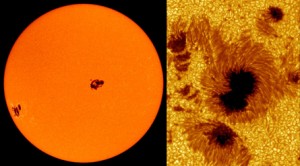Not seeing sunspots
Scientists predict a delay for the sun’s next cycle

The sun is vital for life on Earth: It determines our calendars, keeps us warm and delivers energy to plants. Not surprisingly, scientists keep a close eye on the sun, looking for signs of change. If the sun changes, there’s a good chance we’ll feel the effects on Earth.
The sun usually follows a pattern of activity that lasts 11 years. This pattern is known as the solar cycle. Near the beginning of the solar cycle, sunspots appear in increasing numbers near the poles. Sunspots are dark dots that show up on the sun’s surface, and they are caused by magnetic activity. (Don’t stand outside on a sunny day to look for them: Staring directly at the sun causes permanent eye damage.)
Astronomers have been counting sunspots and tracking solar cycles for 400 years. For the most part, the sun has behaved according to the 11-year pattern. But recent studies of sunspots and other observations of the sun suggest that the sun’s cycle may not be starting on schedule this time.
“The next cycle may be very much more delayed, or may not happen at all,” Frank Hill told Science News. Hill is a physicist at the National Solar Observatory in Tucson. Hill and his colleagues recently studied the surface of the sun and didn’t detect the telltale changes that happen at the start of a new solar cycle.
The sun could be heading into hibernation, which means it will quiet down for decades. It’s happened before: The last sun slowdown lasted from 1645 until 1715. During those years, Europe experienced some of the coldest winters on record.

If the sun is taking a break, physicists don’t know how our climate might be affected this time. Earth’s atmosphere is very different than it was 350 years ago. It now contains more greenhouse gases, like carbon dioxide, that have been accumulating since the beginning of the Industrial Revolution 200 years ago.
When fossil fuels like coal are burned, they release carbon dioxide into the air. Those greenhouse gases insulate the Earth and trap heat. As a result, temperatures are climbing. Physicists don’t know how an insulated Earth will respond to decreased solar activity.
On the other hand, it’s possible that the sun isn’t headed into a recess. The new sun cycle might just be running a few years, and not decades, late. Dean Pesnell, a physicist at NASA’s Goddard Space Flight Center in Greenbelt, Md., told Science News that the new studies indicate “that the next solar cycle will be delayed by two to five years,” or longer.
Three different teams of researchers presented studies about the solar cycle at a June 14 meeting of sun scientists in Las Cruces, N.M. In one study, Hill and his team looked for changes on the surface caused by sound waves that bounce around the sun’s interior. In the past, this type of study was able to predict the start of a solar cycle; this time, the physicists didn’t see the signs of a start-up.
In the other two studies, scientists looked at the sun’s magnetic fields. Magnetic activity drives the sun’s cycle, and those studies showed that magnetic field activity right now isn’t strong enough to jump-start a cycle. One of the studies shows that the magnetic field actually has weakened over the past 13 years. In the near future, the field may be too weak to form sunspots.
The trio of new studies suggests something strange is afoot in our nearest star, although not everyone agrees the sun’s about to take a long break. For scientists, a mystery or an unanswered question is another chance to learn more about the universe and everything in it. As Pesnell told Science News, “It’s a great time to be a solar physicist.”
POWER WORDS
solar Relating to the sun.
physics The scientific study of matter and energy.
sunspot A spot or patch appearing from time to time on the sun’s surface, appearing dark by contrast with its surroundings.
greenhouse gas A gas that contributes to the greenhouse effect by absorbing heat. Carbon dioxide is an example of a greenhouse gas.







